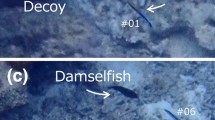Summary
One color-banded black-capped chickadee flock was studied intensively at a winter feeder in Wisconsin. Flock structure was examined by measuring association among flock members in three ways: spatial proximity, temporal association, and association of individuals during flock movements. Additional information was obtained on aggressive interactions at and near the feeder. By midwinter, the strongest attachments were between males and females who subsequently mated; pair attachments strengthened as the breeding season approached. Lower ranked individuals in the dominance hierarchy showed weaker associations with other flock members in early spring than did more dominant individuals. The strong attachment to the mate may have implications for altruistic behavior within the winter flock.
Similar content being viewed by others
References
Barnes JAG (1975) The titmice of the British Isles. David and Charles, Newton Abbot, England
Brown JL (1975) The evolution of behavior. Norton, New York
Dice LR (1945) Measures of the amount of ecological association between species. Ecology 26:297–302
Ficken MS, Witkin SR (1977) Responses of black-capped chickadee flocks to predators. Auk 94:156–157
Ficken MS, Ficken RW, Witkin SR (1978) The vocal repertoire of the black-capped chickadee. Auk 95:34–48
Glase JC (1973) Ecology of social organization in the black-capped chickadee. Living Bird 12:235–267
Hamerstrom F (1942) Dominance in winter flocks of chickadees. Wilson Bull 54:32–42
Odum EP (1942) Annual cycle of the black-capped chickadee. Auk 59:499–531
Siegel S (1956) Nonparametric statistics for the behavioral sciences. McGraw Hill, New York
Weise CM (1971) Population dynamics of the black-capped chickadee. Univ Wisc Field Stn Bull 4:6–11
Weise CM, Meyer JR (1979) Juvenile dispersal and development of site — fidelity in the black-capped chickadee. Auk 96:40–55
Witkin SR, Ficken MS (1979) Chickadee alarm calls: Does mate investment pay dividends? Anim Behav 27:1275–1276
Author information
Authors and Affiliations
Rights and permissions
About this article
Cite this article
Ficken, M.S., Witkin, S.R. & Weise, C.M. Associations among members of a black-capped chickadee flock. Behav Ecol Sociobiol 8, 245–249 (1981). https://doi.org/10.1007/BF00299522
Received:
Accepted:
Issue Date:
DOI: https://doi.org/10.1007/BF00299522




